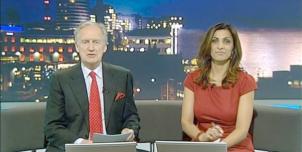Full Freeview on the Lark Stoke (Gloucestershire, England) transmitter
| Google map | Bing map | Google Earth | 52.082,-1.729 or 52°4'53"N 1°43'43"W | GL55 6LS |
The symbol shows the location of the Lark Stoke (Gloucestershire, England) transmitter which serves 38,000 homes. The bright green areas shown where the signal from this transmitter is strong, dark green areas are poorer signals. Those parts shown in yellow may have interference on the same frequency from other masts.
This transmitter has no current reported problems
The BBC and Digital UK report there are no faults or engineering work on the Lark Stoke (Gloucestershire, England) transmitter._______
Digital television services are broadcast on a multiplexes (or Mux) where many stations occupy a single broadcast frequency, as shown below.
64QAM 8K 3/4 27.1Mb/s DVB-T MPEG2
H/V: aerial position (horizontal or vertical)
The Lark Stoke (Gloucestershire, England) mast is a public service broadcasting (PSB) transmitter, it does not provide these commercial (COM) channels: .
If you want to watch these channels, your aerial must point to one of the 80 Full service Freeview transmitters. For more information see the will there ever be more services on the Freeview Light transmitters? page.
Which Freeview channels does the Lark Stoke transmitter broadcast?
If you have any kind of Freeview fault, follow this Freeview reset procedure first.Digital television services are broadcast on a multiplexes (or Mux) where many stations occupy a single broadcast frequency, as shown below.
64QAM 8K 3/4 27.1Mb/s DVB-T MPEG2
H/V: aerial position (horizontal or vertical)
The Lark Stoke (Gloucestershire, England) mast is a public service broadcasting (PSB) transmitter, it does not provide these commercial (COM) channels: .
If you want to watch these channels, your aerial must point to one of the 80 Full service Freeview transmitters. For more information see the will there ever be more services on the Freeview Light transmitters? page.
Which BBC and ITV regional news can I watch from the Lark Stoke transmitter?

BBC Midlands Today 2.9m homes 10.9%
from Birmingham B1 1RF, 45km north-northwest (345°)
to BBC West Midlands region - 66 masts.

ITV Central News 2.9m homes 10.9%
from Birmingham B1 2JT, 46km north-northwest (345°)
to ITV Central (West) region - 65 masts.
All of lunch, weekend and 80% evening news is shared with Central (East)
How will the Lark Stoke (Gloucestershire, England) transmission frequencies change over time?
| 1984-97 | 1997-98 | 1998-2011 | 2011-13 | 7 Mar 2018 | |||||
| A K T | A K T | A K T | K T | K T | |||||
| C23 | ITVwaves | ITVwaves | ITVwaves | D3+4 | D3+4 | ||||
| C26 | BBC2waves | BBC2waves | BBC2waves | BBCA | BBCA | ||||
| C29 | C4waves | C4waves | C4waves | ||||||
| C30 | -BBCB | BBCB | |||||||
| C33 | BBC1waves | BBC1waves | BBC1waves | SDN | |||||
| C36 | ArqA | ||||||||
| C41 | +SDN | ||||||||
| C44 | ArqA | ||||||||
| C47 | ArqB | ||||||||
| C48 | _local | _local |
tv_off Being removed from Freeview (for 5G use) after November 2020 / June 2022 - more
Table shows multiplexes names see this article;
green background for transmission frequencies
Notes: + and - denote 166kHz offset; aerial group are shown as A B C/D E K W T
waves denotes analogue; digital switchover was 6 Apr 11 and 20 Apr 11.
How do the old analogue and currrent digital signal levels compare?
| Analogue 1-4 | 6.3kW | |
| SDN, ARQA, ARQB, BBCA, D3+4, BBCB | (-7dB) 1.26kW | |
| Mux 1*, Mux 2*, Mux A*, Mux B*, Mux C*, Mux D* | (-24dB) 25W |
Local transmitter maps
Lark Stoke Freeview Lark Stoke AM/FM Lark Stoke TV region BBC West Midlands Central (West micro region)Which companies have run the Channel 3 services in the Lark Stoke transmitter area
|
Saturday, 20 October 2012
Syd Wall: Lark Stoke is vertically polarised (aerial vertical) whereas any Anglia transmitters that you "might" pick up (as you say, they will probably be weak or not available at your location) are horizontally polarised. So all in all, the chances of picking up such signals with a vertically-polarised aerial is nil.
What I would do is confirm that your receiver is tuned to Lark Stone for all signals. Do this by viewing the signal strength screen whilst on one of the services carried on each multiplex. A multiplex is a single signal that carries multiple services, for example, PSB1 carries BBC One, BBC Two, and other standard definition BBC services.
For Lark Stone they are:
PSB1 | BBC One | C26
PSB2 | ITV1 | C23
PSB3 | BBC One HD | C30 (only applicable for HD receivers)
COM4 | ITV3 | C41
COM5 | Pick TV | C44
COM6 | Film4 | C47
For example, go to BBC One and bring up the signal strength screen and it should say that it is tuned to C26. If it's not, then it is receiving from another transmitter and this needs correcting. (I say this on the understanding that your aerial points to Lark Stone rather than Sutton Coldfield.)
The six channels used by Sutton Coldfield are (given in the same order as above):
43, 46, 40(HD), 42, 45, 39
| link to this comment |
Tuesday, 24 September 2013
N
noco12:44 PM
Worcester
We are in south Worcestershire and get reception from Sutton Coldfield which is undergoing work. For several weeks now the reception has been dodgy; then BBC chanels [43] went critical. Last night @ around 19.30 hours ITV [46] went dead.
When will this end?
Can you get arefund on your TV Licence??
| link to this comment |
noco's: mapN's Freeview map terrainN's terrain plot wavesN's frequency data N's Freeview Detailed Coverage
S
Sid8:26 PM
Nothing to do with the transmitter it's due to the high pressure weather.
| link to this comment |
Monday, 25 November 2013
S
Syd Wall1:11 PM
Shipston-on-stour
Hi,
I retuned my HDR Fox T2 around the start of November after seeing messages for some time that Film 4 was changing channels.
After doing so, I found that a number of channels were not being received on their standard numbers. For instance, ITV had little or no reception on channel 3 but was coming in strong on 800. Similarly, the HD channels are not coming in on channel 101/102 etc but are spread around the 838 to 843 range.
Having examined the multiplex channel numbers, I can see that I am receiving a good signal from Larkstoke, but the Humax is allocating 800 numbers to the two multiplex channels C23 and C30. All other channels are on their correct numbers.
I retuned again when I realised a couple of days later but it returned the same results. How can I make the Humax allocate the right channel numbers to the channels received from the strongest local transmitter?
Anyone else getting this problem since Film4 moved?
| link to this comment |
Syd's: mapS's Freeview map terrainS's terrain plot wavesS's frequency data S's Freeview Detailed Coverage
M
Michael1:17 PM
Syd Wall: From memory of Humax boxes, go into the installation menu, then default setting and do a scan for channels - but when it finishes, choose delete all. Go back to the installation menu and then manual search - and put in numbers 23 26 30 41 44 and 47.
| link to this comment |
S
Syd Wall10:03 PM
Shipston-on-stour
Thanks Michaelhad the manual tune in mind as a last resortI wanted to see if there is a reason why it's not tuning as it should, automatically
| link to this comment |
Syd's: mapS's Freeview map terrainS's terrain plot wavesS's frequency data S's Freeview Detailed Coverage
K
KMJ,Derby11:32 PM
Syd Wall: All boxes scan from UHF C21 to C69 when searching automatically for channels. Many will put the first set of channels found in the "normal" positions of the channel list then put any subsequent channels that are identified as having a regional variation in the 800s. A few tuners will put the last set found in the "normal" positions, displacing those found first into the 800s.There are even some that sort out the strongest signal for the main channel list then put the alternatives in the 800s, to the annoyance of viewers who struggle to pick up their local region whilst getting full strength from a neighbouring region. The latest tuners give an option to choose the regional preference when two or more regions are identified, however I have heard of cases where the correct BBC1 and ITV were placed at "1" and "3" but the rest of the channel list was filled on a first come first served basis with channels from the wrong transmitter! Manual tuning is really the only method guaranteed to enter the correct frequencies for your particular requirements.
| link to this comment |
M
Michael11:34 PM
Syd Wall: Normally this problem occurs when it picks up a weaker signal on a low UHF channel and assigns it to the guide in the correct place - but there's no other UHF I can see that would do that.
Did you notice which UHF channels were assigned to the poorer BBC1 and ITV channels before you retuned?
| link to this comment |
Monday, 2 December 2013
S
Syd Wall3:32 PM
Shipston-on-stour
Syd Wall: Hi Michael
poor signal on BBC1HD/BBC2HD/ITVHD etc comes in on 101/102/103 etc in CH40
Good signal on above channels comes in on 840/838/841 on CH 30
Poor signal on ITV/Ch4/Ch5 etc comes in on 3/4/5 on CH 46.
Good signal on above channels comes in on 800/802/807 etc on CH23
(i.e., Dave Lindsay, it is tuning automatically but it's not allocating numbers correctly automatically)
KMJ..thanks. My Humax has scanned automatically from UHF 21to 69 and correctly allocated channel numbers for years. I just want to know what the reasons are for it not doing so now! Humax say nothing wrong with the box and the transmitters aren't doing anything different.
| link to this comment |
Syd's: mapS's Freeview map terrainS's terrain plot wavesS's frequency data S's Freeview Detailed Coverage
Select more comments
Your comment please!




